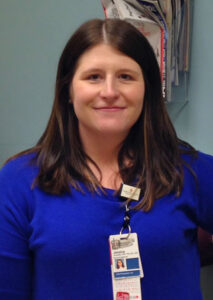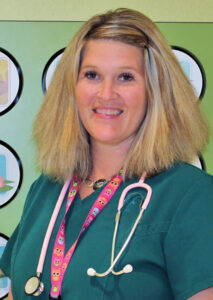Sleep-related breathing disorders affect an estimated 18 million people in the U.S. AARC members Jessica Schweller, MS, RRT, CNP, and Amber Galer, BS, RRT, are helping patients sleep by making sure they get the testing and treatment they need for a better night’s rest.

How they got here
Schweller traces her interest in sleep back to her undergraduate training in respiratory care. After she went to work at a local hospital, however, she says she “sort of forgot about it.” When she became a nurse practitioner (NP), though, she saw so many people with sleep issues her former interest was revived.
“When I took my job in the sleep clinic, I was amazed at what a difference you can truly make in a person’s life by improving their sleep,” says the sleep NP at The Ohio State University Lung and Sleep Center in Columbus. “With my RT background, it was a perfect transition for me as an NP.”
Galer, who works in the pediatric sleep lab at Primary Children’s Hospital in Salt Lake City, UT, had a more personal reason for getting involved. “I have a son that experienced night terrors, sleep walking, cyclic sickness, and chronic nocturnal coughing from infancy,” she explains. Physicians couldn’t come up with any answers, and multiple attempts to ease his problems led to little improvement.

Challenges and rewards
For Schweller, the rewards in practicing sleep medicine come in the form of helping patients overcome what, for some, seem like almost insurmountable problems when they first walk into the door of the center. That can start with acquiring coverage for the sleep testing and treatment in the first place.
“Running into roadblocks from insurance companies and durable medical equipment suppliers can be difficult,” she admits. “I feel that my job is mostly clinical, however, I have to be a patient advocate and investigator for a good majority of my day.”
She has to be a cheerleader of sorts for the treatments that are prescribed as well. “You try your best to do what is right for the patient, but in sleep, many patients have ‘tried everything and just want a quick fix,’” she says. “I pride myself in spending time with my patients, educating them on sleep hygiene, and trying to improve sleep quality and PAP compliance.”
The challenges posed by adults with sleep problems are multiplied many-fold when it comes to children, says Galer. Many of the kids who come to her lab for testing have complicated medical issues, and even kids who are otherwise healthy require special handling.
“Imagine for yourself the fears you had when you were small. Now imagine you are told you are going to have a sleep study in a hospital with approximately 30 wires on your head and body, possibly a mask on your face, or your trach capped while you sleep, and the pressures and settings you are used to at home to help you breathe are going to be tweaked while you sleep,” she says. “Not to mention the possibility of a capillary blood gas poke before and after the study.”
She gets creative to ease those fears, turning the EEG cap into a “web cap” for kids who like superheroes, or a princess cap (with the wires becoming a royal ponytail) for little girls who see themselves as the next Elsa or Ariel. She makes sure to explain everything she’s doing as well; using age appropriate language, even the babies get a blow-by-blow description of what’s happening to them.
Next steps
Schweller suggests anyone with an interest in sleep contact a sleep center in their area to find out what opportunities may exist. “I would encourage therapists as well to attend local, state, and national respiratory conferences and sleep meetings if possible and also to check out some of the sleep lectures and posters at the AARC. Connecting with therapists who work in an area you may be interested in is not only a great way to network but also see if something new is right for you.”
Galer believes sleep medicine is worth looking into for any RT, as it offers a variety of routes of entry, from in-hospital sleep labs to outpatient facilities to home-based testing. When it comes to pediatric sleep, she reminds her fellow therapists that scoring rules are different for kids, and testing requires a lot of out-of-the-box thinking to achieve a successful study.
“A respiratory therapist interested in pediatric sleep needs patience and flexibility in work routine, and you must be quick on your feet—you never know when a race car, action figure, rattles, blocks, or dolls will be incorporated into the set up.”



